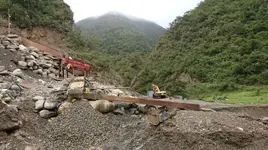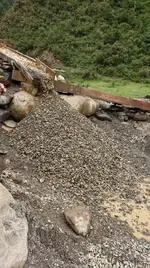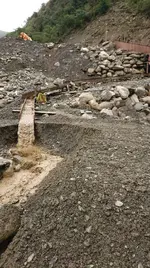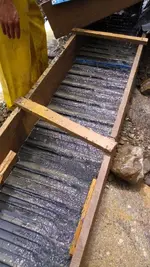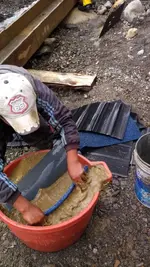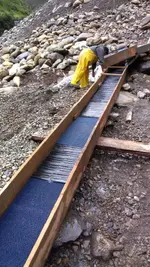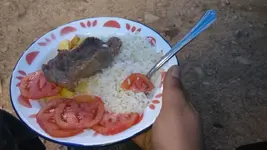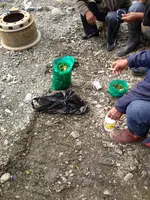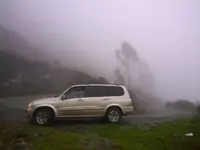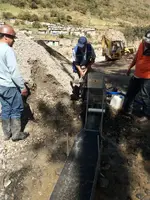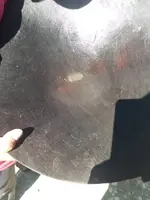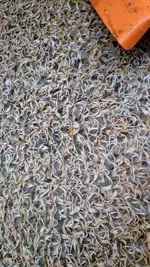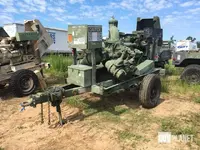aescal
Jr. Member
- Joined
- Nov 13, 2012
- Messages
- 29
- Reaction score
- 106
- Golden Thread
- 0
- Primary Interest:
- All Treasure Hunting
After pulling most of my equipment out of Tacacoma (only flood gold on surface, nothing on bedrock) I ventured to Yungas province of La Paz Bolivia to visit a mine I recently sold a 320C excavator to. These friends have scores of tailings, as a result of mediocre washplant that blows out almost all the fine gold. Upon arriving since my last visit they had moved their washplant, and I had some lumber brought in to make a quick sluice to test the GoldHog mats Ive had in storage for about a year. This mining area lies east of La Paz and is only about 2 hours away from my home, making it much more accessible by SUV (only 3 streams to cross, and my SUV is pretty low to the ground).
Heres a view of the valley
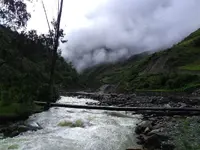
Heres a view of the Mine from Above (flooded hole where they reached bedrock)
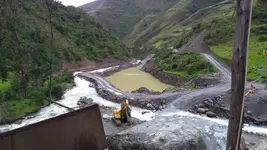
The washplant as seen from below
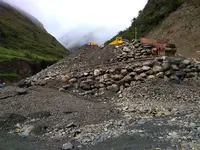
Tailings the new locations
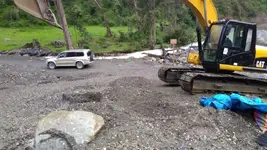
I went with 46.5cm mats, cutting down the 36 inch mats into 2 and joining them in sections. The idea to run two 3.6mt planks quickly fell apart once we tried unloading the boards off the dump truck. A hardwood named Achachira, the 46.5cm x 2inch x 3.6mt boards must have weighed about 200#s each. You can hit them with a sledgehammer and it wont make a dent. The idea being to add a sluice run below their existing plant (everyone thinks their runs are perfect, and refuse to adjust them) with a 1/2 screen to classify the material coming out of their run and into the new boxes.
Here you can see the lumber and first box installed.
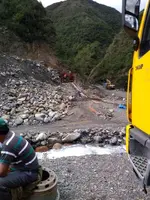
The screen never made it (was left behind), so we adapted sheet of expanded metal and gutter tin as a classifier. Not the best setup but it worked decent (would have liked to have a higher pitch but we did everything by hand in the middle of the rain before lunch). Once it was setup we ate lunch (staple of rice, boiled potatoes and a piece of boiled chicken), and went to work as soon as the rain stopped. I was concerned that it would continue raining as the streams grow my car would have trouble crossing them back out. After lunch they ran one dump truck, and the makeshift classifier worked great.
Here you can see the classifer working and the waves over the Scrubber mat.
IMO they run too little water for their 80cm sluice. I pointed that out to them, but they are using water from a pond up above the mine as they dont have the funds for diesel to run the pump below the plant. The area they worked orginally had flooded and with the rainy season upon us its pointless to try to pump it out.
The clean out from the first truck was good. Scores of fine gold in every batea (wooden pan).
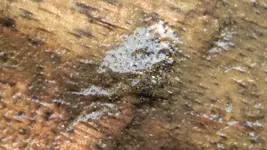
Here the gentleman panning it down in the batea
We ran into a hiccup on the second truck. The screen at the plant is a perforated sheet of iron with 2" holes. They are afraid that if they go down in size a lemon-size piece of gold will blow over. It results in 80% of the material the truck being run thru the sluices. And with the little water they use at the moment it clogged up in the bottom of the box. Taking a long stick to it resulted in a tsunami of material blowing out and running down their sluice and burying the sluice I installed. Like literally buried under 1' of material.
Heres the aftermath after digging it out by hand
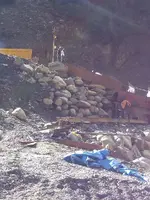
All in all it was a good experience, I am scheduled to return on Sunday when they have promised to build up a platform to put the new sluice run.
Interestingly enough, the first run had fines in it as seen in the picture. The later stuff out of the trucks had mercury covered fines. Not a single speck uncovered. Since the mines upstream are hardrock mines and crush their ore and use mercury to recover it we can only assume thats where the mercury covered gold is coming from.
I think with time and a little elbow grease adding on a good size run can help these guys increase their recovery rates. In the meantime Im waiting on my Raptor and Champion pump to arrive so that on the weekends I can head out there and spend some time just working the tailings.
Total recovered is maybe 1 gram, but considered we used an old 5 gallon bucket with Hydraulic fluid residue and did everything on the run it was a pretty good....
Heres a view of the valley

Heres a view of the Mine from Above (flooded hole where they reached bedrock)

The washplant as seen from below

Tailings the new locations

I went with 46.5cm mats, cutting down the 36 inch mats into 2 and joining them in sections. The idea to run two 3.6mt planks quickly fell apart once we tried unloading the boards off the dump truck. A hardwood named Achachira, the 46.5cm x 2inch x 3.6mt boards must have weighed about 200#s each. You can hit them with a sledgehammer and it wont make a dent. The idea being to add a sluice run below their existing plant (everyone thinks their runs are perfect, and refuse to adjust them) with a 1/2 screen to classify the material coming out of their run and into the new boxes.
Here you can see the lumber and first box installed.

The screen never made it (was left behind), so we adapted sheet of expanded metal and gutter tin as a classifier. Not the best setup but it worked decent (would have liked to have a higher pitch but we did everything by hand in the middle of the rain before lunch). Once it was setup we ate lunch (staple of rice, boiled potatoes and a piece of boiled chicken), and went to work as soon as the rain stopped. I was concerned that it would continue raining as the streams grow my car would have trouble crossing them back out. After lunch they ran one dump truck, and the makeshift classifier worked great.
Here you can see the classifer working and the waves over the Scrubber mat.
IMO they run too little water for their 80cm sluice. I pointed that out to them, but they are using water from a pond up above the mine as they dont have the funds for diesel to run the pump below the plant. The area they worked orginally had flooded and with the rainy season upon us its pointless to try to pump it out.
The clean out from the first truck was good. Scores of fine gold in every batea (wooden pan).

Here the gentleman panning it down in the batea
We ran into a hiccup on the second truck. The screen at the plant is a perforated sheet of iron with 2" holes. They are afraid that if they go down in size a lemon-size piece of gold will blow over. It results in 80% of the material the truck being run thru the sluices. And with the little water they use at the moment it clogged up in the bottom of the box. Taking a long stick to it resulted in a tsunami of material blowing out and running down their sluice and burying the sluice I installed. Like literally buried under 1' of material.
Heres the aftermath after digging it out by hand

All in all it was a good experience, I am scheduled to return on Sunday when they have promised to build up a platform to put the new sluice run.
Interestingly enough, the first run had fines in it as seen in the picture. The later stuff out of the trucks had mercury covered fines. Not a single speck uncovered. Since the mines upstream are hardrock mines and crush their ore and use mercury to recover it we can only assume thats where the mercury covered gold is coming from.
I think with time and a little elbow grease adding on a good size run can help these guys increase their recovery rates. In the meantime Im waiting on my Raptor and Champion pump to arrive so that on the weekends I can head out there and spend some time just working the tailings.
Total recovered is maybe 1 gram, but considered we used an old 5 gallon bucket with Hydraulic fluid residue and did everything on the run it was a pretty good....
Amazon Forum Fav 👍
Upvote
0



 )
)
